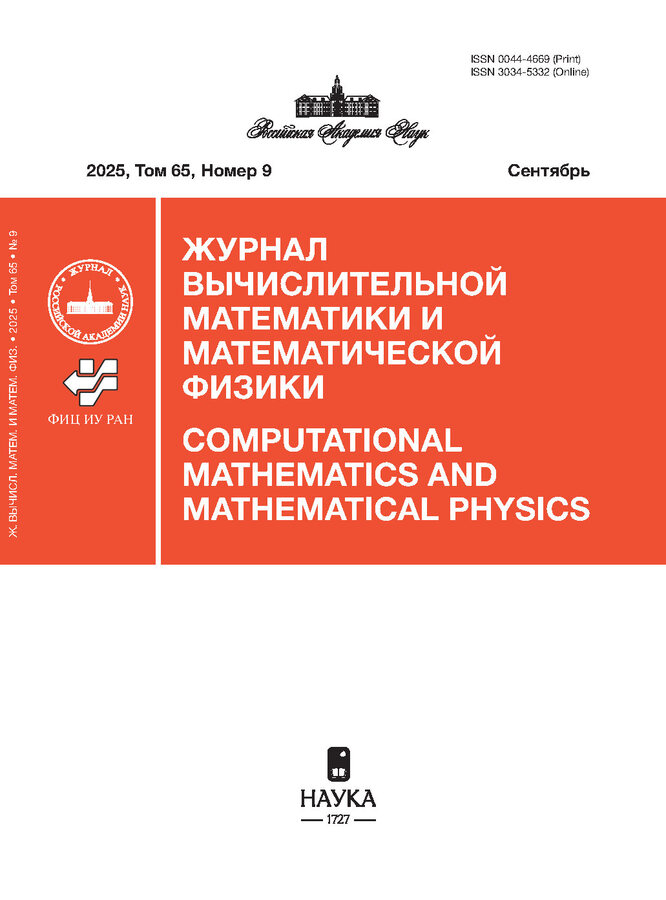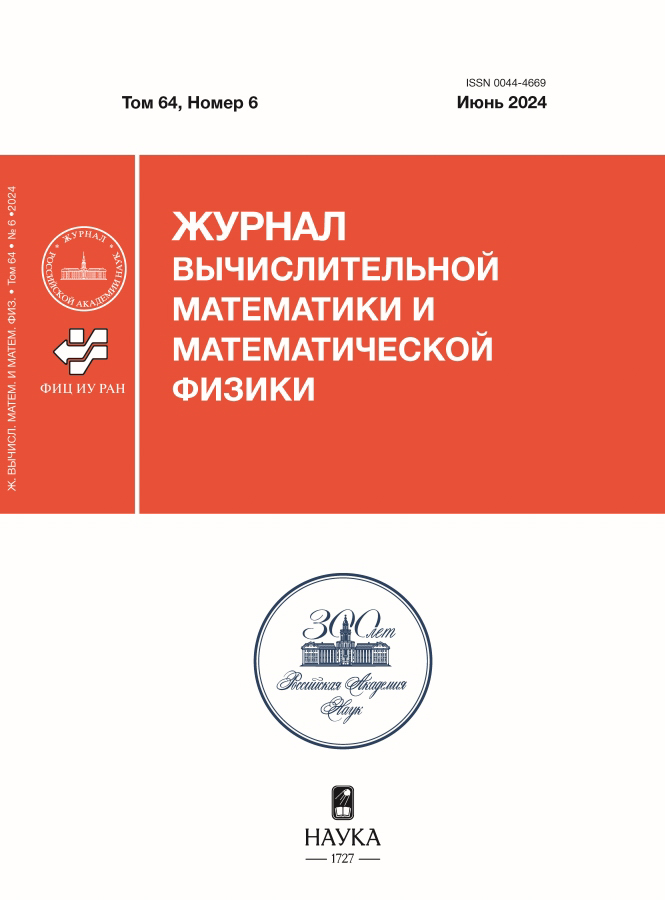PROBLEMS OF DETERMINING QUASI-STATIONARY ELECTROMAGNETIC FIELDS IN WEAKLY INHOMOGENEOUS MEDIA
- Authors: Kalinin A.V.1,2, Tyukhtina A.A.1, Malov S.A.1
-
Affiliations:
- National Research Lobachevsky State University of Nizhny Novgorod
- Institute of Applied Physics, Russian Academy of Sciences
- Issue: Vol 64, No 6 (2024)
- Pages: 1064-1081
- Section: Mathematical physics
- URL: https://clinpractice.ru/0044-4669/article/view/665068
- DOI: https://doi.org/10.31857/S0044466924060144
- EDN: https://elibrary.ru/XYBGFT
- ID: 665068
Cite item
Abstract
Statements of initial-boundary value problems for the system of Maxwell equations in various quasi-stationary approximations in homogeneous and inhomogeneous conducting media are considered. In the case of weakly inhomogeneous media, asymptotic expansions of solutions of the initial-boundary value problems under consideration in a parameter characterizing the degree of inhomogeneity of the medium are formulated and substantiated. It is shown that the construction of an asymptotic expansion for a quasi- stationary electromagnetic approximation leads to a sequential solution of independent problems for a quasi- stationary electric and quasi-stationary magnetic approximation in a homogeneous medium. Conditions on the initial data are given for which the asymptotic series are convergent.
About the authors
A. V. Kalinin
National Research Lobachevsky State University of Nizhny Novgorod; Institute of Applied Physics, Russian Academy of Sciences
Email: avk@mm.unn.ru
Nizhny Novgorod, 603022 Russia; Nizhny Novgorod, 603950 Russia
A. A. Tyukhtina
National Research Lobachevsky State University of Nizhny Novgorod
Email: tyukhtina@iee.unn.ru
Nizhny Novgorod, 603022 Russia
S. A. Malov
National Research Lobachevsky State University of Nizhny NovgorodNizhny Novgorod, 603022 Russia
References
- Ландау Л. Д., Лифшиц Е. М. Теоретическая физика. Том 8. Электродинамика сплошных сред. М.: Наука, Физматлит, 1982.
- Тамм И. Е. Основы теории электричества. М.: Наука, 1989.
- Толмачев В. В., Головин А. М., Потапов В. С. Термодинамика и электродинамика сплошной среды. М.: Изд-во МГУ, 1988.
- Raviart P.-A., Sonnendrücker E. A hierarchy of approximate models for the Maxwell equations // Numer. Math. 1996. V. 73. P. 329–372.
- Larsson J. Electromagnetics from a quasistatic perspective // Am. J. Phys. 2007. V. 75. N 3. P. 230–239.
- Kruger S. E. The three quasistatic limits of the Maxwell equations // arXiv:1909.11264, 2019.
- Kalinin A. V., Tyukhtina A. A. Hierarchy of models of quasi-stationary electromagnetic fields // MMST 2020, Revised Selected Papers. CCIS, v. 1413. Springer, 2021. P. 77–92.
- Kalinin A. V., Slyunyaev N. N. Initial-boundary value problems for the equations of the global atmospheric electric circuit // J. Math. Anal. Appl. 2017. V. 450. N 1. P. 112–136.
- Alonso Rodriguez A., Valli A. Eddy current approximation of Maxwell equations. Theory, algorithms and applications. Milan: Spriner-Verlag Italia, 2010.
- Degond P., Raviart P.-A. An analysis of the Darwin model of approximation to Maxwell’s equations // Forum Math. 1992. V. 4. P. 13–44.
- Kaufman A. N., Rostler P. S. The Darwin model as a tool for electromagnetic plasma simulation // Phys. Fluids. 1971. V. 14. N 2. P. 446–448.
- Hewett D. W., Boyd J. K. Streamlined Darwin simulation of nonneutral plasmas // J. Comput. Phys. 1987. V. 70. P. 166–181.
- Krause T. B., Apte A., Morrison P. J. A unified approach to the Darwin approximation // Phys. Plasmas 2007. V. 14. 102112.
- Sonnendrücker E., Ambrosiano J. J., Scott T. Brandon S. T. A finite element formulation of the Darwin PIC model for use on unstructured grids // J. Comp. Phys. 1995. V. 121. N 2. P. 281–297.
- Ciarlet P. Jr., Zou J. Finite element convergence for the Darwin model to Maxwell’s equations // Math. Modeling Numer. Anal. 1997. V. 31. N 2. P. 213–249.
- Fang N., Liao C., Ying L. A. Darwin Approximation to Maxwell’s Equations // ICCS 2009. Lecture Notes in Computer Science. V. 5544. Berlin: Springer, 2009.
- Koch S., Schneider H., Weiland T. A low-frequency approximation to the Maxwell equations simultaneously considering inductive and capacitive phenomena // IEEE Trans. Magn. 2012. V. 48. P. 511–514.
- Badics Z., Pavo J., Bilicz S., Gyimothy S. Subdomain perturbation finite element method for quasi-static Darwin approximation // IEEE Trans. Magn. 2020. V. 56. N 1. Art no. 7503304.
- Yan S., Tang Z., Henneron T., Ren Z. Structure-preserved reduced-order modeling for frequency-domain solution of the Darwin model with a gauged potential formulation // IEEE Trans. Magn. 2020. V. 56. N 1. Art no. 7500404.
- Clemens M., Kasolis F., Henkel M.-L., Kähne B., Günther M. A two-step Darwin model time-domain formulation for quasi-static electromagnetic field calculations // IEEE Trans. Magn. 2021. V. 57. N 6. P. 1–4.
- Мареев Е. А. Достижения и перспективы исследований глобальной электрической цепи // Успехи физ. наук. 2010. Т. 180. N 5. С. 527–534.
- Калинин А. В., Слюняев Н. Н., Мареев Е. А., Жидков А. А. Стационарные и нестационарные модели глобальной электрической цепи: корректность, аналитические соотношения, численная реализация // Известия РАН. Физика атмосферы и океана. 2014. Т. 50. N 3. С. 314–322.
- Slyunyaev N. N., Кalinin A. V., Mareev E. A. Thunderstorm generators operating as voltage sources in global electric circuit models // J. Atm. Solar-Terr. Phys. 2019. V. 183. P. 99–109.
- Shalimov S. L., Bösinger T. An alternative explanation for the ultra-slow tail of sprite-associated lightning discharges // J. Atm. and Solar-Terr. Phys. 2006. V. 68. N 7. P. 814–820.
- Калинин А. В., Тюхтина А. А. Некоторые математические задачи атмосферного электричества // Итоги науки и техники. Совр. мат. прил. 2022. Т. 207. С. 48–60.
- Raviart P.-A., Sonnendrücker E. Approximate models for the Maxwell equations // J. Comput. Appl. Math. 1994. V. 63. P. 69–81.
- Ciarlet P., Sonnendrücker E. A Decomposition of the electromagnetic field – application to the Darwin model // Math. Mod. Meth. Appl. Sci. 1997. V. 07. N 8. P. 1085–1120.
- Fang N., Ying L. Three dimensional exterior problem of the Darwin model and its numerical computation // Math. Mod. Meth. Appl. Sci. 2008. V. 18. N 10. P. 1673–1701.
- Liao C., Ying L. An analysis of the Darwin model of approximation to Maxwell equations in 3-D unbounded domains // Comm. Math. Sci. 2008. V. 6. N 3. P. 695–710.
- Калинин А. В., Тюхтина А. А. Приближение Дарвина для системы уравнений Максвелла в неоднородных проводящих средах // Ж. вычисл. матем. и матем. физ. 2020. Т. 60. N 8. С. 121–134.
- Темам Р. Уравнения Навье––Стокса. Теория и численный анализ. М.: Мир, 1981.
- Girault V., Raviart P. Finite element methods for Navier––Stokes equations. N.Y.: Springler-Verlag, 1986.
Supplementary files











